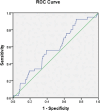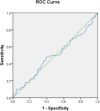Predictive value of body mass index (BMI) and determination of optimum cut-off point in the diagnosis of endometrial hyperplasia in pre-menopausal women with abnormal uterine bleeding
- PMID: 38463922
- PMCID: PMC10921111
- DOI: 10.22088/cjim.15.1.9
Predictive value of body mass index (BMI) and determination of optimum cut-off point in the diagnosis of endometrial hyperplasia in pre-menopausal women with abnormal uterine bleeding
Abstract
Background: The suitable BMI cut-off point in persons with endometrial cancer or hyperplasia with abnormal uterine bleeding was investigated in this study.
Methods: This case-control research was conducted on 1470 women with abnormal uterine bleeding in Ayatollah Rouhani Hospital,Babol between 2010 and 2012, with 312 participants included in the study. In terms of uterine biopsy results, patients were split into six groups: simple hyperplasia without atypia, simple hyperplasia with atypia, complicated hyperplasia with atypia, complex hyperplasia without atypia, endometrial cancer, and normal persons.
Results: The mean age and BMI of patients in these three groups were not significantly different (P equal to 0.081 and 0.435, respectively). The kind of disease exhibited a strong relationship with menstruation (P 0.001). The body mass index (BMI) values did not have significant levels under the curve to determine the appropriate cut-off point in the diagnosis of hyperplasia plus endometrial cancer and endometrial cancer alone (P 0.380 and 0.124, respectively) and hyperplasia alone (P = 0.920). Based on logistic regression, age 50 years and older and irregular menstruation were significant with OR equal to 2.36 and 2.09 (P = 0.011) and HTN with OR equal to 0.44 (P = 0.026), respectively.
Conclusion: BMI has little predictive value in the detection of endometrial cancer or hyperplasia, according to the findings, and other diagnostic and screening modalities should be utilized instead. The findings backed up the theory that old age and irregular menstruation are linked to an increased risk of endometrial cancer.
Keywords: Abnormal uterine bleeding; Body mass index; Endometrial cancer; Endometrial hyperplasia; Infertility..
Conflict of interest statement
None declared by the authors.
Figures





Similar articles
-
Endometrial Thickness Measurement as Predictor of Endometrial Hyperplasia and Cancer in Perimenopausal Uterine Bleeding: Cross-Sectional Study.Asian Pac J Cancer Prev. 2023 Feb 1;24(2):693-699. doi: 10.31557/APJCP.2023.24.2.693. Asian Pac J Cancer Prev. 2023. PMID: 36853321 Free PMC article.
-
Body mass index trumps age in decision for endometrial biopsy: cohort study of symptomatic premenopausal women.Am J Obstet Gynecol. 2016 Nov;215(5):598.e1-598.e8. doi: 10.1016/j.ajog.2016.06.006. Epub 2016 Jun 8. Am J Obstet Gynecol. 2016. PMID: 27287687
-
Could body mass index be an indicator for endometrial biopsy in premenopausal women with heavy menstrual bleeding?Arch Gynecol Obstet. 2016 Aug;294(2):395-402. doi: 10.1007/s00404-016-4043-8. Epub 2016 Feb 20. Arch Gynecol Obstet. 2016. PMID: 26895636
-
Levonorgestrel intrauterine system for endometrial protection in women with breast cancer on adjuvant tamoxifen.Cochrane Database Syst Rev. 2020 Dec 21;12(12):CD007245. doi: 10.1002/14651858.CD007245.pub4. Cochrane Database Syst Rev. 2020. PMID: 33348436 Free PMC article.
-
Ultrasonographic evaluation of the endometrium in postmenopausal vaginal bleeding.Radiol Clin North Am. 2003 Jul;41(4):769-80. doi: 10.1016/s0033-8389(03)00060-5. Radiol Clin North Am. 2003. PMID: 12899491 Review.
References
-
- Torre LA, Siegel RL, Ward EM, Jemal A. Global cancer incidence and mortality rates and trends—an update. Cancer Epidemiol Biomarkers Prev. 2016;25:16–27. - PubMed
-
- Grady D, Gebretsadik T, Kerlikowske K, Ernster V, Petitti D. Hormone replacement therapy and endometrial cancer risk: a meta-analysis. Obstet Gynecol. 1995;85:304–13. - PubMed
-
- Hickey M, Doherty D, Fraser I, Sloboda D, Salamonsen L. Why does menopausal hormone therapy lead to irregular uterine bleeding? Changes to endometrial blood vessels. Hum Reprod. 2008;23:912–8. - PubMed
-
- Lethaby A, Hussain M, Rishworth JR, Rees MC. Progesterone or progestogen‐releasing intrauterine systems for heavy menstrual bleeding. Cochrane Database Syst Rev. 2015:CD002126. - PubMed
-
- Marnach ML, Laughlin-Tommaso SK, editors Evaluation and management of abnormal uterine bleeding. Mayo Clin Proc. 2019;94:326–35. - PubMed
LinkOut - more resources
Full Text Sources
